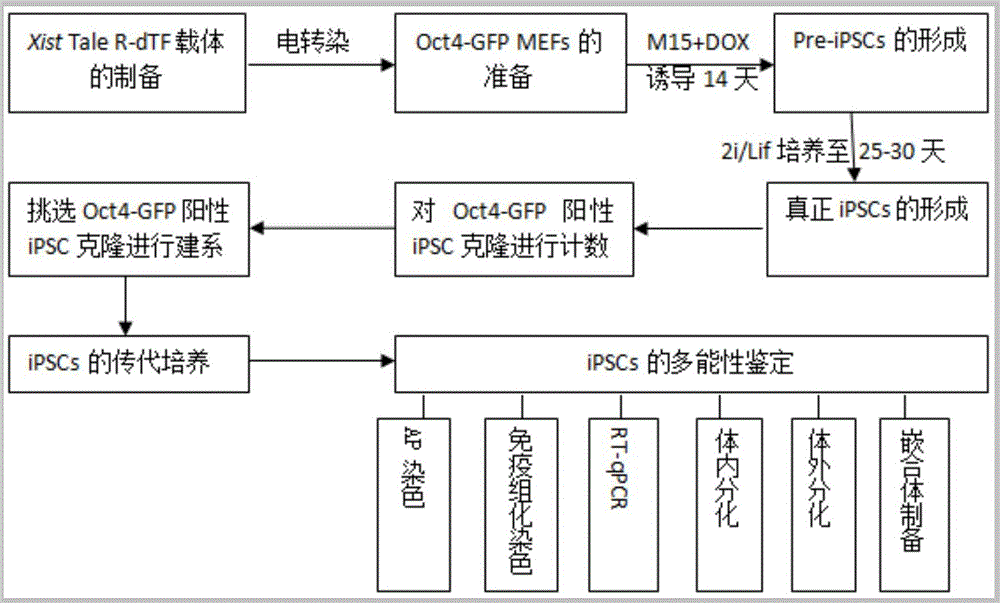Method for preparing induced pluripotent stem cells by using Xist Tale inhibitory transcription factor
A technology of pluripotent stem cells and transcription factors, applied in artificially induced pluripotent cells, biochemical equipment and methods, animal cells, etc., can solve the problems of low-efficiency iPSCs, restrict the development and application of ESCs technology, and improve the induction efficiency. Effect
- Summary
- Abstract
- Description
- Claims
- Application Information
AI Technical Summary
Problems solved by technology
Method used
Image
Examples
Embodiment 1
[0049] Embodiment 1: the preparation of carrier
[0050] The mouse Oct4Tale R-dTF vector (Reprogramming to pluripotency usingdesigner TALE transcription factors targeting enhancers (Gao et al., 2013)) was used to engineer Tale R-dTF (R6) that specifically recognizes and binds to the first intron region of Xist, The final R6 is an expression vector driven by the Doxycycline (Dox)-dependent promoter TRE carried by the PB vector (for the structure and binding site of the Xist Tale inhibitory effector R6, see figure 2 and image 3 ). The specifically identified DNA sequence is TTAAGTGTTATGGACAAGGA (reference gene sequence number in GeneBank: NC_000086.7)
Embodiment 2
[0051] Example 2: Preparation of feeder cells
[0052] Take the MEFs that have grown to 80% confluence within 3-5 passages, discard the original culture solution, add 6 mL of the MEF culture solution with a final concentration of 10 mg / L mitomycin C, and treat the cells in a 100 mm cell culture dish for 2.5 hours; discard Add 5 mL of D-PBS to the culture medium to wash the cells, repeat 3 times, completely remove mitomycin C, add 2 mL of 0.5 g / L trypsin-0.02% EDTA digestion solution, incubate and digest at 37 °C for 1 min, and place under an inverted phase-contrast microscope After observing that the cells shrink and become round, gently pat the side wall of the culture dish with your hands, and the cell layers will come off from the bottom of the dish. At this time, add an equal amount of M10 culture medium to stop digestion; Perform pipetting and mixing, collect the cell suspension into a 15mL centrifuge tube for cell counting, then centrifuge at 1000r / min for 3min, discard ...
Embodiment 3
[0053] Embodiment 3: Establishment of Oct4-GFP MEFs
[0054] Sexually mature C57BL / 6J female mice and MF1, 129 / sv male mice carrying Oct4-GFP were caged at a ratio of 1(♂):2(♀), and the pregnant mice at 13.5 days old were cesareaned to obtain fetuses, and washed Finally, remove the head, limbs and tail, wash and cut into pieces, digest with 0.5g / L trypsin-0.02% EDTA digestion solution in a 37°C water bath for 20min, and mix several times during the period; continue to add 0.5g / L trypsin Protease-0.02% EDTA digestion solution, digested in a water bath at 37°C for 20min. After mixing by pipetting, culture medium was added to stop the digestion, and centrifuged at 1000rpm for 10min. Discard the supernatant, add an appropriate amount of culture medium, pipette about 10 times repeatedly, place in a T25 culture bottle at 37°C, 5% CO 2 Culture in the incubator (Oct4-GFP MEFs growth status see Figure 4 ), after reaching 80% confluence, subculture and culture at 1:3-1:5, and other ...
PUM
 Login to View More
Login to View More Abstract
Description
Claims
Application Information
 Login to View More
Login to View More - R&D
- Intellectual Property
- Life Sciences
- Materials
- Tech Scout
- Unparalleled Data Quality
- Higher Quality Content
- 60% Fewer Hallucinations
Browse by: Latest US Patents, China's latest patents, Technical Efficacy Thesaurus, Application Domain, Technology Topic, Popular Technical Reports.
© 2025 PatSnap. All rights reserved.Legal|Privacy policy|Modern Slavery Act Transparency Statement|Sitemap|About US| Contact US: help@patsnap.com



